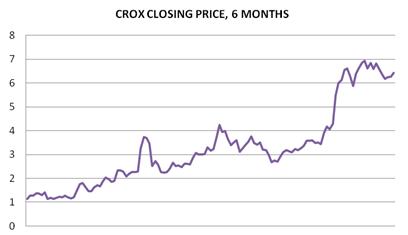If you type the term “crocs” into Twitter’s search box, you will get a comprehensive overview of what the naysayers think about Crocs, including the company, the shoes, and its management. You will identify the following criticisms:
- Crocs are COYOTE UGLY.
- Knockoffs are cheaper; there is no need to buy Crocs.
- Crocs are a short-term fad.
- The company is mismanaged.
- In July, The Washington Post reported that Crocs was on its way to bankruptcy. The company is doomed.
This basically sums up the chat-room discussions. Readers might accept these ideas, dismiss Crocs, and believe the Washington Post’s thesis. However, if you look at the company’s stock performance in 2009, the market clearly anticipates something else for Crocs. How do you reconcile market expectations with the above-mentioned negatives? You simply drill down into each issue, focus your analysis on the facts, and separate the wheat from the chaff. Let me address each issue individually.

1. Crocs are COYOTE UGLY.
Some people like the Crocs Clog style; others simply hate it. This is fair. However, a quick look at the Crocs website will convince you that there is more to Crocs than clogs. Crocs sells comfortable, durable shoes in a wide variety of appealing styles for men, women, and children, and the company offers great value. The naysayers seem to view Crocs merely as a clog marketer. Nothing could be further from the truth.
2. Knockoffs are cheaper; there is no need to buy Crocs shoes.
Crocs’ customers are convinced imitations DO NOT feel as good as the real Crocs shoe. That is as true with Crocs as it is true of some other companies. For example, some people will spend much more money on a Tempur-Pedic mattress than on a cheaper imitation. They believe the satisfaction they get from using the real thing surpasses the money they save by using the fake thing. This trade-off is worth it to them. Crocs are no different.
In addition, as Crocs diversifies its product line into more than the 120 styles currently available, the imitators will have their work cut out for them to keep up with Crocs’ pace. As Crocs introduces styles more frequently, its product life cycle shrinks, making it more difficult for imitators to put products on the shelves on a timely basis. The retailers might not want to deal with this complexity for the low-margin product.
3. Crocs are a short-term fad.
Ever since its shoes became popular, people have labeled Crocs as a fad. However, in a “Best of 2008” list, Crocs appeared in two categories:
- Bestselling Products: Categories Shoes and Handbags (Amazon.com and Endless.com): Crocs Cayman Sandal.
- Most-loved Products: Categories Shoes and Handbags (Amazon.com and Endless.com): Crocs Athens Thong Sandal.
As of today, Crocs are still at the top of the chart at Amazon.com. The company’s second-quarter results confirm the shoes are selling briskly. For some customers, Crocs are simply an addiction. John Duerden, Crocs’ CEO, commented, “There are more than 100 million consumers in 125 countries that love our product. The Crocs brand is only five years old, and already it’s almost as well-known as Nike and Adidas. It’s an icon and whether people love it or hate it, they talk about it.” In short, Crocs has products that resonate with consumers. To put the company’s achievement in perspective, it took a hundred years for Citibank to achieve its hundred million customers mark.
4. The company is mismanaged.
Crocs’ challenges are deeply rooted in the company’s torrid growth prior to 2008. Since the company could barely meet demand in 2006 and 2007, management overestimated the amount of inventory needed to satisfy demand. Therefore, when the economy turned south in 2008 and Crocs’ clog business matured, sales fell sharply.
To address these issues, on February 25, 2009, Crocs announced that it had appointed John Duerden to serve as the company’s president and chief executive officer. Crocs released this statement: “Duerden has more than 20 years of senior level management experience across a variety of industries, including thirteen years as president or CEO. From 1990 to 1995, Duerden served as president and chief operating officer of Reebok International. During this time, the company’s worldwide sales tripled to $3 billion and Reebok became established as a pre-eminent international sports brand.”
Duerden quickly took action to address the company’s challenges. He focused on aligning its production capacity to meet demand, reducing its overhead expenses and its workforce, paying down debt, and managing its product life cycle tightly.
Duerden’s strategy is bearing fruit. The company’s inventory, which topped $250 million in 2007, is now standing at $116 million, and it is decreasing.
5. In July, The Washington Post reported that Crocs was on its way to bankruptcy. The company is doomed.
Crocs has always been a debt-light company, considering its size. That was the case before The Washington Post published its report. While the Post was busy penning its article, Crocs was repaying its debt. When Crocs reported second quarter results, it announced it had paid back its debt and had $77 million in cash. Inflammatory headlines sell newspapers, and they create investment opportunities. Judging from market activity, market participants regarded the article as having no value.
In closing, Crocs enjoys one of the best mindshares in the shoe business. As Crocs successfully overcomes its main challenges, expect the business to strive. While I am sure the skepticism about and criticism of the company will continue, at least until such time as it becomes more clear that Crocs’ transformation is gaining traction, Crocs’ fundamentals are improving, and the company is well positioned to thrive and deepen its sustainable advantage.
Michael
Disclaimer: This article is not a recommendation of CROX the stock but an opinion about Crocs as a business. The author owns CROX in different legal entities and his hedge fund.

 Saturday, September 26, 2009 at 12:01PM
Saturday, September 26, 2009 at 12:01PM

